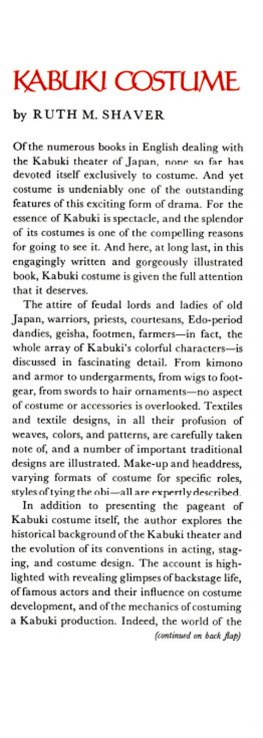ONNAGATA
Onnagata
A LABYRINTH OF GENDERING IN KABUKI THEATER
Maki Isaka

: Lynda Hart, Motherhood According to Finley: The Theory of Total Blame, TDR 36, no. 1 (Spring 1992): 124134, published by MIT Press.
Parts of appeared previously in my article The Gender of Onnagata as the Imitating Imitated: Its Historicity, Performativity, and Involvement in the Circulation of Femininity, positions: east asia cultures critique 10, no. 2 (Fall 2002): 245284.
Parts of appeared previously in my article Women Onnagata in the Porous Labyrinth of Femininity: On Ichikawa Kumehachi I, U.S.-Japan Womens Journal, nos. 3031 (2006): 105131.
Parts of the epilogue appeared previously in my article What Could Have Happened to Femininity in Japanese Stagecraft: A Memorial Address to Yamada Isuzu (19172012), positions: asia critique 21, no. 3 (Summer 2013): 755759.
2016 by the University of Washington Press
Printed and bound in the United States of America
Composed in Warnock Pro, typeface designed by Robert Slimbach
19 18 17 16 5 4 3 2 1
All rights reserved. No part of this publication may be reproduced or transmitted in any form or by any means, electronic or mechanical, including photocopy, recording, or any information storage or retrieval system, without permission in writing from the publisher.
University of Washington Press
www.washington.edu/uwpress
Library of Congress Cataloging-in-Publication Data
Isaka, Maki.
Onnagata : a labyrinth of gendering in kabuki theater / Maki Isaka.
pages cm
Includes bibliographical references and index.
ISBN 978-0-295-99510-6 (hardcover : alk. paper)
1. KabukiHistory. 2. ActorsJapanHistory. 3. Female impersonatorsJapanHistory. I. Title.
PN2924.5.K3I77 2015
792.0952dc23
2015033571
The paper used in this publication is acid-free and meets the minimum requirements of American National Standard for Information SciencesPermanence of Paper for Printed Library Materials, ANSI Z39.481984.
To Ako-san
Contents
Preface and Acknowledgments
THIS book comprises two primary ingredients: gender studies and onnagata, actors playing womens roles in all-male kabuki theater in Japan. This combination alone is rather mundane today, but how the book combines them and what the combination generates are not. It will discuss, for example, gender as gait, gender as adoptees, and female onnagata in modern times as legitimate participants in mens world of kabuki: proven to be capable but obliterated from historiography nevertheless. The conclusion of this book is simple. Far from popular images of onnagata as the creators of some extraordinary femininity independent of womens everyday femininity, the labyrinth of gendering they show us is rather an ordinary one: intricate yet porous, precarious but binding, and codependent on the labyrinths of others.
As they are arguably the most radical cross-gender performers, female onnagata are capable of showing us an exemplary labyrinth of gendering. Furthermore, they deserve special attention not so much because they are an underestimated periphery invisible in kabuki historiography todaywhich is true in its own rightas because they belonged to an abjected part of the mainstream, which was obliterated due to the advent of a modern gender economy and for the sake of the mainstreams survival amid it. (They were dismissed not merely on their own merits. Their existence in the mainstream threatened its own cultural identity and, by extension, existence. Female onnagata had to be erased for that precise reason. In short, they were not simply rejected but abjected.) Ultimately, this phenomenon concerns the question of who is made to pay the price for establishing, naturalizing, and maintaining a system, a significant question indispensable to gender studies.
This books commitment to not only male but also female onnagata does not indicate lack of appreciation for kabuki or onnagata. On the contrary, I am a kabuki admirer who relishes onnagata acting. I just see no need to deny female onnagata in order to appreciate male onnagata, just as we can appreciate both contraltos and countertenors at the same time. I count myself lucky to have witnessed quite a few impressive onnagata, including Kataoka Gad XIII (19101993), Nakamura Utaemon VI (19172001), Nakamura Shikan VII (19282011), Sawamura Sjr IX (19332001), and Band Tamasabur V (b. 1950). They are, in one way or another, onnagata of moment for kabuki history. Arguably, Utaemon and Tamasabur have been two epochal onnagata in the postWorld War II era, representing two radically new types of onnagata respectively (radically new at their respective times), while Gad, Shikan, and Sjr have demonstrated ways in which contemporary onnagata negotiate between present-day kabuki dramaturgy and the seemingly ancien taste of onnagata acting. Theirs is not simply individual acting. For example, when he was deeply engaged in training under the tutelage of Shikan, Tamasabur vividly demonstrated the power of training by which one creates a being. Although not related by blood to Shikan, Tamasabur at that time looked and sounded as if he were a loyal son who resembles his father very much. It has been my good fortune to witness the performances of these onnagata not only as a kabuki fan but also as someone who writes about it. This book, however, has almost nothing to do with my own theatergoing experiences, primarily because this project is a textual analysis of discourse on and by onnagata and also because the book covers a time period that is much longer than my lifetime.
This book would have been impossible had it not been for foundational library research in Japan, generously made possible by a Charles A. Ryskamp Research Fellowship from the American Council of Learned Societies, for which I am sincerely grateful. I would also like to express my gratitude to the University of Minnesota, whose awards generously supported the several stages of this project. I am also lucky to have interacted with audiences who contributed to the development of this project through their much appreciated interest as well as questions and comments. I am thankful to them and to hosting institutions including Carleton College, Duke University, Midwest Japan Seminar, Northern Michigan University, University of Michigan, University of Minnesota, University of North Carolina at Chapel Hill, and Western Michigan University.
Published works on the topic of gender and onnagata have enabled me to grew; and What Could Have Happened to Femininity in Japanese Stagecraft: A Memorial Address to Yamada Isuzu (19172012), positions: asia critique 21, no. 3 (Summer 2013): 75559, which informs the epilogue. Two other short essays in anthologies contain ideas that are now developed and spread throughout this book: Box-Lunch Etiquette: Conduct Guides and Kabuki Onnagata, in Manners and Mischief: Gender, Power, and Etiquette in Japan, edited by Jan Bardsley and Laura Miller (2011), 4866; and Images of Onnagata: Complicating the Binarisms, Unraveling the Labyrinth, in PostGender: Gender, Sexuality and Performativity in Japanese Culture, edited by Ayelet Zohar (2009), 2238. Each of these earlier works has been significantly expanded here with the addition of new material and translations, more questions and arguments, and even different conclusions on some occasions. The same is true of the present book as well: my hearty thanks go to Lorri Hagman, executive editor at the University of Washington Press, and two anonymous reviewers, for their helpful comments. I also extend my thanks to the future readers of this book.
Next page








